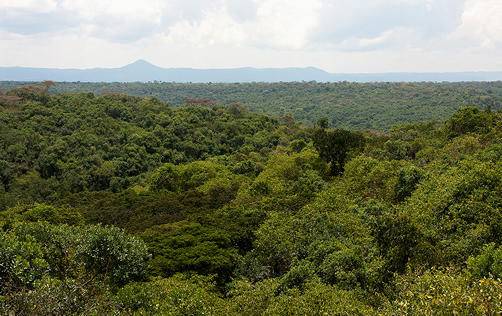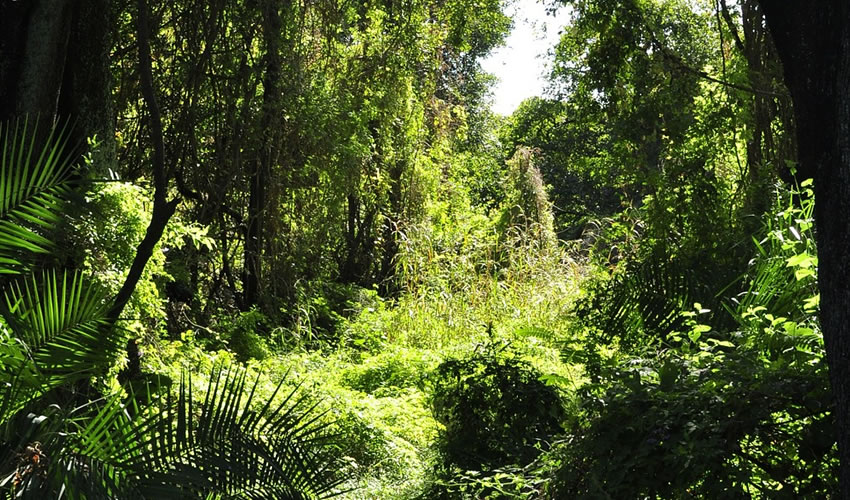The Maramagambo forest reserve is part of Queen Elizabeth national park. The borders of the reserve are formed by Lake Edward to the west and the Kichwamba escarpment to the east. Two explosion crater-filled lakes of Nyamusingiri and Kyasandukale are located on its northern edge.
There’s a raised viewing platform that offers beautiful rift valley scenery. The deck was an initiative of the Uganda Wildlife Authority and the Center for Disease Control to prevent Marburg virus disease transmission from the Maramagambo forest bats. The largest colony of fruit-eating bats in East Africa is said to reside in the forest.
A Dutch traveler contracted the disease a couple of years ago whilst hiking on the nature trails to caves and volcanic lava tubes where the bats reside. He survived and the platform was built to minimize contact while maintaining the bat watching sites. Maramagambo forest also serves as a corridor between the two sectors of Queen Elizabeth national park which include the northern Kasenyi plains and the Ishasha wilderness to the south.
The forest helps to sustain ecological connectivity across the larger conservation area. Large mammal species including lions and elephants are able to move uninterrupted across their habitat range. In particular, forest elephants that come from the contiguous Virunga in DR Congo are known to move via Ishasha and Maramagambo forest to Sebitoli in Kibale forest national park where they have become permanent residents.
The Kajojo River, which drains the Maramagambo Forest, was actually named “elephant trail” since it serves as a pathway for African elephants. A hike along the Kajojo river trail offers an opportunity to explore the rich biodiversity of Maramagambo forest. The Queen Elizabeth National Park offers boat cruises on the Kazinga channel and game drives. Those intending to see something different other than keeping around the savanna can visit Maramagambo forest to learn about the flora and fauna in the dense evergreen tropical forest. Thanks to the 5 nature trails available for visitors to hike through different habitats such as riverine forests, raffia palm trees, and waterfalls.
Vegetation

Maramagambo forest is located a few kilometers south of the equator line. Given that it is not directly on the leeward side of the Rwenzori mountain range, it receives higher amounts of rainfall than the northern Kasenyi plains. As such, Maramagambo stays hot and humid all year. It is dominated by tropical broad-leaved evergreen tree species including frame tree, Uganda ironwood (Cynometra-Celtis), hissing tree (Parinari curatellifolia), and dragon tree (Dracaena marginata).
Some parts of the reserve along the shores of lake Edward contain a forest of raffia palm trees, which grow up to 24 meters. The fishermen use the leaf fronds to make fishing ponds on the Rwenshama Landing site. They are also used by women for making mats and other handicrafts. The Rwenshama was developed into a modern integrated fish landing site through the Lakes Edward and Albert Integrated Fisheries and Water Resources Management Project thereby increasing the productivity of fish, income, and food security as a way to minimize dependency on the forest resources.
This has helped to conserve Maramagambo central forest reserve while ensuring sustainable utilization of fish. Unlike the adjacent Kalinzu forest, Maramagambo has remained untouched, of which much of its area is a primary habitat. Supporting a rich biodiversity including over 300 bird species, over 5 of Uganda’s 110 fruit-eating bat species, reptiles such as African rock python which feeds on the bats, and several primate species including chimpanzees, blue monkeys, black and white colobus monkeys.
Nature walks and hiking trails in the Maramagambo forest

There are over 5 nature paths that allow visitors to explore various habitats such as open and dense forests, raffia palms, volcanic caves where bats live, and the Kilyantama waterfalls along the Kajojo river. There’s a chance to encounter chances while hiking in the Maramagambo forest, though there are no guarantees.
The river trail is 1 km long where visitors walk through the riverine forest where elephants created ponds. Similar elephant bathing ponds are in Ruhija in Bwindi impenetrable forest national park. Birding along the Kajojo river trail is superb. You’re likely to spot some birds that live in the riverine forests such as the tambourine dove (Turtur tympanistria), Gray-headed (Halcyon leucocephala) and Blue-breasted (Halcyon malimbica) kingfishers. Deep in the jungle, you might encounter chimps, blue monkeys, black and white colobus monkeys, and olive baboons.
Palm forest trail
The palm forest trail extends for 5 km along the shores of Lake Edward through the palm forest to the open woodlands. Along this trail you will understand how the palms are useful in providing raw materials for women to make mats. Being on the shores, hiking the palm forest trail is easiest due to the nature of terrain.
Waterfalls trail
The longest hike is to reach the Kilyantama waterfalls trail, which is 11 km long. Walking above 1,000 m above sea level makes for an intermediate level of hiking for anyone to do. Besides the waterfalls, one of the highlights is to see the Mutuba tree (Ficus natalensis) used to make barkcloth. You can witness the traditional art of barkcloth making at Kasota Village, in Kasota Parish, Maanyi Sub County, Mityana District, Uganda.
Bat cave observatory and blue lake trail
The trail uncovers the hidden views of the blue crater lakes when standing at the built platform raised above at the height of tree canopies. There are chances to spot the African rock pythons.
Kichwamba escarpment village walk
Those intending to interact with the local people can visit the Kichwamba Escarpment Community Tourism Initiative. The walk around the village lasts for 2 hours and the highlights include visiting a school, farm to see how local food is grown and prepared, and a traditional healer for his stunning metaphysics. Those interested can even sample the coffee and have their lunch served at the local restaurants.
Visiting Maramagambo forest is one of the unique things to do in addition to the game drives and boat cruises along Kazinga channel. There’s only one mid range accommodation on the twin lakes called Jacana lodge at the northern edge of the forest. Most of the lodges are found within the Queen Elizabeth national park.




